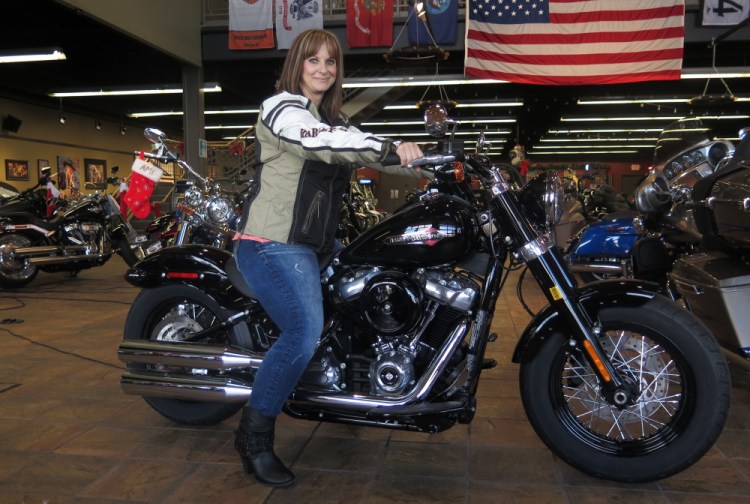MILWAUKEE — Harley-Davidson is placing a renewed emphasis on teaching people to ride as part of its efforts to attract more customers.
The Milwaukee-based company’s decision to expand the number of dealerships with a Harley “Riding Academy” comes as the industry grapples with years of declining sales and an aging customer base.
The program launched in 2000 with about 50 locations, and now 245 dealerships in the U.S. offer the three- or four-day course. The company says about a quarter of those launched since 2014.
Harley sold 124,777 new motorcycles over nine months in 2017, down from 135,581 during the same period the previous year, according to the company’s most recent earnings report.
The Motorcycle Industry Council says the median age of motorcycle owners has increased from 32 to 47 since 1990. About 46 percent of riders are over 50; only about 10 percent are 30-34.
Samantha Kay rode on the back of her father’s motorcycle growing up, but when the 25-year-old took a class to ride for the first time, she couldn’t help being anxious.
“I think motorcycles inherently do scare a lot of people,” said Kay, a Milwaukee woman who is one of 50,000 people nationwide who took a riding course at a Harley-Davidson dealership this year.
The training is one of the ways Harley is trying to attract a new generation of riders like Kay amid big demographic shifts.
“Some of the aging Baby Boomers, which have been the guts of Harley-Davidson’s purchasers, they’re getting older and some of them are just getting out of the sport because they can’t handle the motorcycle anymore,” said Clyde Fessler, who retired from Harley-Davidson in 2002 after holding several executive positions over 25 years. He created what became the Riding Academy.
He said the idea “is getting people comfortable on a motorcycle and getting them to feel safe and confident.”
In addition to riders getting older, a slow economic recovery has made it harder for millennials to buy new motorcycles, said Jim Williams, vice president of the American Motorcyclist Association. Among the newest models, a 2018 Softail Slim starts at $15,899 and a 2018 Sportster Forty-Eight at $11,299.
“The younger generations are buying plenty of motorcycles, they’re just not new,” Williamssaid.
But it’s not all the millennials’ fault, said Robert Pandya, who managed public relations for Indian Motorcycles and Victory Motorcycles. Pandya recently launched “Give A Shift,” a volunteer group discussing ideas to promote motorcycling. One of their conclusions, he said, is the idea that “if mom rides, the kids will ride.”
Currently, women are about 14 percent of the riding population, according to the Motorcycle Industry Council.
“The biggest possible opportunity in motorcycling is to invite more women to ride,” he said.
That’s not lost on Harley-Davidson. Among the ways Harley-Davidson is trying to reach younger riders is by having motorcycle role models such as Jessica Haggett, the founder of the “The Litas” all-women motorcycle club, be a voice for the company on social media. And the company is also focusing advertising efforts in male-dominated sports such as UFC events popular with millennials.
“I think we have to work harder to gain share of mind with young adults, for example, in that they have other activities in their lives. They’re on screens, they’re connecting socially, they’re involved in gaming, they’re involved in other things,” said Heather Malenshek, Harley-Davidson’s vice president of marketing.
She said the easily customizable Sports Glide model that launched in November and the aggressive, performance-driven Fat Bob also have younger riders in mind. In all, the company plans to release 100 new motorcycles over the next 10 years. During that time, the company also wants to gain 2 million new riders.
Terri Meehan took plenty of motorcycle rides with friends as a passenger but has wanted to be in the driver’s seat for a while. The 42-year-old took the Harley-Davidson riding course in October because she wanted to learn from “an expert who could teach the right way versus someone who had learned bad habits.”
The price of the class varies by dealership, but it’s generally about $300. Students spend time in class learning about motorcycle safety and on ranges learning to ride. Meehan plans to buy a motorcycle soon.
“My son’s a psychology major, so he asked me if I was going through a mid-life crisis, which is actually quite hilarious,” Meehan said.
Another challenge for Harley-Davidson is that motorcycling simply isn’t a major part of people’s upbringing like it was once, Malenshek said.
“If you think about Baby Boomers, they probably were brought up on a dirt bike or had an uncle or a neighbor or something who was riding around in a Harley-Davidson. That may not be the case today,” she said.
Send questions/comments to the editors.



Comments are no longer available on this story